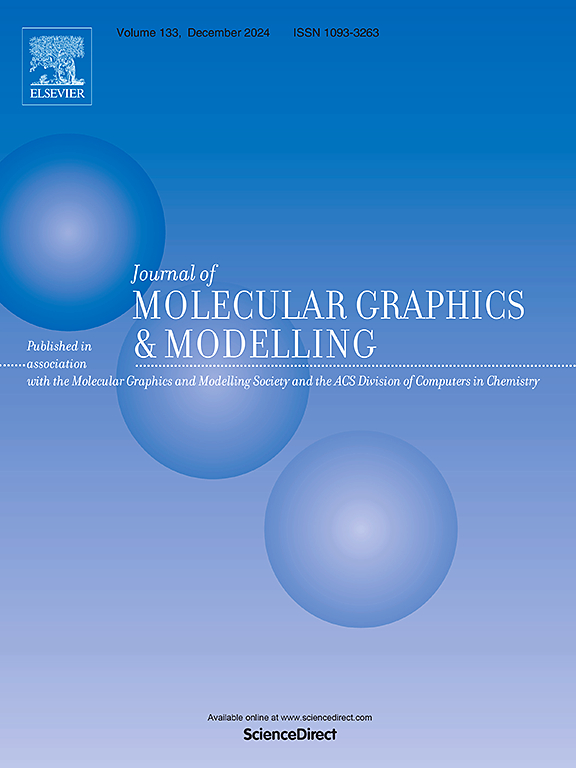oh引发的大气和废水中2,2 ',4,4 ',5,6 ' -六溴化二苯醚(BDE-154)的降解:机制,动力学和生态毒性
IF 3
4区 生物学
Q2 BIOCHEMICAL RESEARCH METHODS
引用次数: 0
摘要
本文采用密度泛函理论(DFT)和过渡态理论(TST)研究了2,2 ',4,4 ',5,6 ' -六溴化二苯基醚(BDE-154)与羟基的反应机理和动力学。计算了M06-2X /6-311 ++G (3df, 3pd)// M06-2X /6-311G (d,p)水平下的气相和水溶液反应机理及动力学参数。BDE-154中非溴取代碳原子的oh加成机制优于取代机制和抽氢机制。在O2/NO存在的情况下,oh加成加合物的二次反应生成三溴苯酚和oh加成产物。大多数转化产物仍然对水生生物有毒。应用kishelp程序评估了760 Torr下258 ~ 328 K的总速率系数和单个速率系数。在298 K和760 Torr下,大气和废水中的总速率系数分别为9.40 × 10−14 cm3分子−1 s−1和3.60 × 106 M−1 s−1。半衰期分别为123.1天和1.93 × 102 ~ 1.93 × 1011秒。这些结果阐明了BDE-154在深度氧化过程中的转化机理、大气命运和生态毒性。本文章由计算机程序翻译,如有差异,请以英文原文为准。

OH-initiated degradation of 2,2′,4,4′,5,6′-hexabrominated diphenyl ether (BDE-154) in the atmosphere and wastewater: Mechanisms, kinetics, and ecotoxicity
In the present work, the reaction mechanism and kinetics of 2,2′,4,4′,5,6′-hexabrominated diphenyl ether (BDE-154) with OH were researched by employing density functional theory (DFT) and transition state theory (TST). The gas-phase and aqueous solution reaction mechanisms and kinetic parameters were computed at the level of M06–2X/6–311++G (3df, 3pd)//M06–2X/6-311G (d,p). The OH-addition of the non-bromine replaced carbon atom of the aromatic ring in BDE-154 is superior to substitution and H-abstraction mechanisms. The secondary reaction referring to OH-addition adducts in the existence of O2/NO will generate tribromophenol and OH-addition products. The majority of conversion products are still poisonous to hydrobiont. The KiSThelP program was applied to assess the overall rate coefficient and the individual rate coefficient at 258–328 K of 760 Torr. The overall rate coefficient at 298 K and 760 Torr are 9.40 × 10−14 cm3 molecule−1 s−1 and 3.60 × 106 M−1 s−1 in atmosphere and wastewater. The half-lives are 123.1 days and 1.93 × 102-1.93 × 1011 s, respectively. These results elucidated the conversion mechanism, atmospheric fate and ecotoxicity of BDE-154 in advanced oxidation procedure.
求助全文
通过发布文献求助,成功后即可免费获取论文全文。
去求助
来源期刊

Journal of molecular graphics & modelling
生物-计算机:跨学科应用
CiteScore
5.50
自引率
6.90%
发文量
216
审稿时长
35 days
期刊介绍:
The Journal of Molecular Graphics and Modelling is devoted to the publication of papers on the uses of computers in theoretical investigations of molecular structure, function, interaction, and design. The scope of the journal includes all aspects of molecular modeling and computational chemistry, including, for instance, the study of molecular shape and properties, molecular simulations, protein and polymer engineering, drug design, materials design, structure-activity and structure-property relationships, database mining, and compound library design.
As a primary research journal, JMGM seeks to bring new knowledge to the attention of our readers. As such, submissions to the journal need to not only report results, but must draw conclusions and explore implications of the work presented. Authors are strongly encouraged to bear this in mind when preparing manuscripts. Routine applications of standard modelling approaches, providing only very limited new scientific insight, will not meet our criteria for publication. Reproducibility of reported calculations is an important issue. Wherever possible, we urge authors to enhance their papers with Supplementary Data, for example, in QSAR studies machine-readable versions of molecular datasets or in the development of new force-field parameters versions of the topology and force field parameter files. Routine applications of existing methods that do not lead to genuinely new insight will not be considered.
 求助内容:
求助内容: 应助结果提醒方式:
应助结果提醒方式:


